Michael Wittmann, the most famous tank driver of the Second World War? Undoubtedly yes. However, the Soviet Union also had its own armored hero, whose achievements would surely equal the exploits of the German hero!
It was August 19, 1941, when the German armored leaders of the Army Group "Nord" were in the area of the town of Krasnogvardeysk (now Gatchina), about 50 km south of Leningrad. From this side, the 8th Panzer Division attacked the former capital of the tsars, mostly equipped with light Panzer II tanks and the Czech Panzer 38 (t).
Commodore commander, Gieman tanks idut!
The 3rd Heavy Tank Company commanded by Lieutenant Zinoviev Kolobanov was in an ambush near the access roads to Krasnogvardeysk from Tallinn. This 28-year-old graduate of the Military Academy. Frunze was already an experienced armadillo at that time. With the rank of captain, he took part in the Soviet-Finnish war, during which he escaped from a burning tank three times.
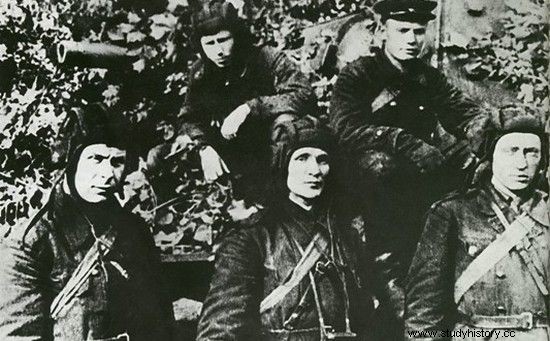
Kolobanov with his crew. In the background, a faithful and, as it turned out, deadly effective KW1 tank.
After signing the peace treaty he was demoted to the rank of private. He was also stripped of all decorations and awards and placed in the reserve for fraternizing too much with the enemy. After the German attack on the USSR, due to his combat experience, he was reinstated as a second lieutenant in his former unit.
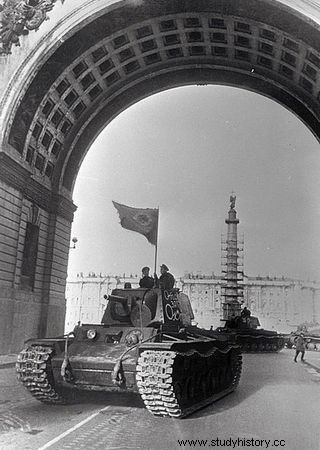
The KW1 tank sets off to fight the Germans near Leningrad. I wonder if his crew scored any hits? (source:RIA Novosti archive; license CC BY-SA 3.0).
Now Lieutenant Kołobanow had a chance to once again prove his worth. The previous day he heard from General Władimir Baranov himself, commander of the 1st Armored Division, the order: Close the approach to the city and fight to the end! The Soviet officer had five KW-1s armed with a 76.2 mm gun at his disposal. All tanks were carefully dug and masked. Each had a double unit of fire, 2/3 of which were anti-tank missiles.
The lieutenant's car took its position by the road, in the vicinity of the "Woiskowica" sovkhoz. From this place, you could clearly see the road running along the marshy lowland and disappearing into the forest visible on the horizon. The remaining company tanks, two each, lined the adjacent roads.
Strength of evil for one
Around At 2 p.m. a German motorcycle reconnaissance appeared on the road, leaving the forest. The scouts stopped every few hundred meters and swept round the roadside bushes with machine guns, trying to locate the alleged enemy positions. Kolobanov decided not to reveal himself and let the motorcyclists pass. He was waiting for the main force.
Indeed, after a long moment, a long armored column emerged from the forest. 22 wagons, the lieutenant counted. The Germans felt confident. In the open hatches of the turrets, you could see laughing tankers in unbuttoned uniforms.
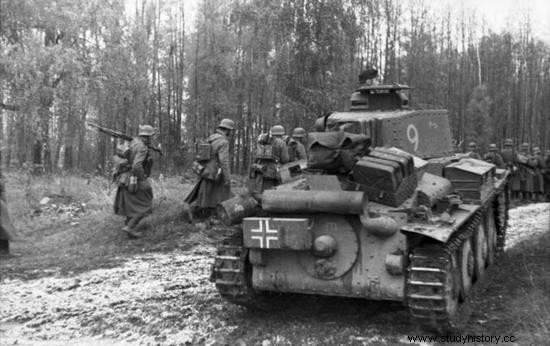
The Panzer 38 (t) tank shown in the photo turned out to be an easy target for the 76 mm KW1 Kołobanov gun. Photo taken in autumn 1941 in the Leningrad area (source:Bundesarchiv; license CC BY-SA 3.0).
The nearest German tank was only 150 meters away from the hidden KW, when finally Lieutenant Kołobanow gave the impatient and slightly anxious crew the order:Fire! The gunner, Sergeant Usow, was a specialist in his trade. The first missile stopped a leading German tank. The second shot and the next tank in the column caught fire. There's a blockage. Usov then moved fire to the tail of the German column. Four missiles were enough and two more enemy machines were destroyed.
Banging your head against the wall
The Germans have not yet located the position of the Soviet car. They fired on nearby straw stacks, which immediately caught fire. The whole neighborhood was shrouded in smoke. Eventually, however, KW was discovered. The fire of the remaining Nazi tanks focused on it. However, it did not make any impression on a Soviet machine.
The shells from the German light cannons only severed the masking and torn off the additional protective panels from the turret, from which now sparks sprinkle with each subsequent hit. Usow, as during maneuvers, calmly and concentratedly places the next missiles, this time in the middle of the enemy column.
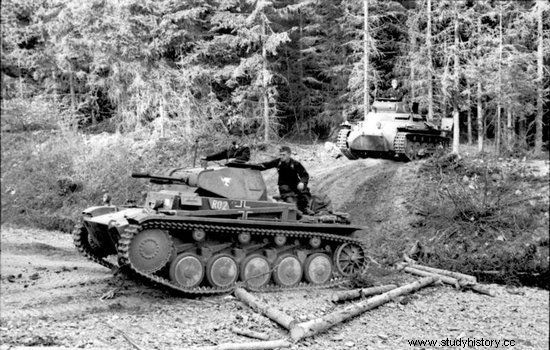
The Panzer II tanks (source:Bundesarchiv; lic. CC BY-SA 3.0) did not stand a chance against him.
German tanks began to maneuver vigorously, trying to break out of the death trap. Some drove off the road into the field, but here they immediately got stuck in the mud. The fate of these machines was doomed. In the end, the Germans called for help on foot. Under the cover of tank guns, it tried to approach the position of the Soviet car. Kolobanov noticed this. This time he ordered the cannon to be loaded with high-explosive shells. Tank machine guns were also heard.
Hit but not sunk
However, in the end, the Soviet tank was damaged many times. The turret rotation mechanism broke down and the entire vehicle had to be maneuvered to point the gun at the target. The panoramic commander's periscope was also destroyed, preventing the lieutenant from observing the foreground. Then the driver-mechanic, senior Nikolai Nikiforov, risking his life, jumped out of the car under fire and replaced the damaged part of the periscope.
There was also a shortage of ammunition for the cannon and after the launch of 98 anti-tank missiles, Lieutenant Kolobanov ordered the machine to be withdrawn. The fight lasted only an hour. There have been 22 burning enemy vehicles counted on the battlefield . It was also observed that several German tanks broke into the vicinity of the sowkhoz buildings.
Heavy cavalry approaches
During the withdrawal, the Soviet commander contacted the battalion commander by radio and reported his position. Captain Szpiller thanked him for the exemplary task and assured him that he had already sent backup. Indeed, two more KWs joined Lieutenant Kołobanow's machine in a short time. From the commanders of these tanks, the lieutenant learned that the remaining tanks of the company also fought the Germans and destroyed 13 more German armored vehicles.
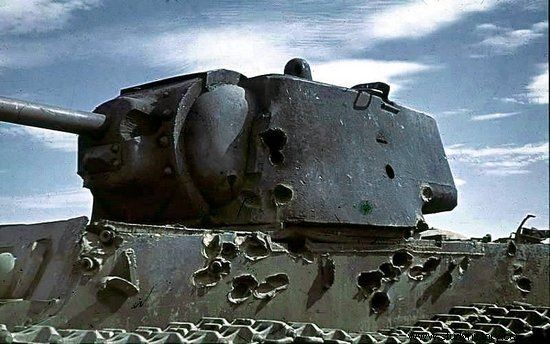
The KW1 tanks were able to withstand a lot, as you can see in the photo above. Kolobanov's car must have looked similar after receiving 156 hits (source:Bundesarchiv; lic. CC BY-SA 3.0).
The newly arrived Soviet tanks immediately went into action. Both of these cars destroyed 8 more enemy machines. The German attack was repulsed. The balance of the battles of the 3rd Tank Company was really impressive. In total, on August 19, Soviet tanks destroyed 43 German machines . On the armor of Lieutenant Kołobanow, there were 156 hits from enemy shells.
Ace awarded
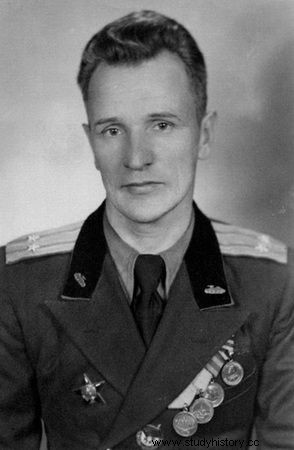
Kolobanov as a lieutenant colonel. Among the decorations, you can see, among others Order of the Red Banner, received for the August 19th campaign.
Lieutenant Zinowiej Kołobanow was awarded the Order of the Red Banner for his merits in the fight at Krasnogvardiejsk. It is surprising that he did not receive the title of Hero of the Soviet Union, although it was the norm that soldiers were given such a title for similar exploits.
On September 21, 1941, Kołobanow was seriously wounded near the town of Pushkin. He returned to the front only in the second half of 1944 as the commander of a battalion of the SU-76 self-propelled guns. For participating in the battles near Magnuszew, he was awarded the Order of the Red Star, and for the Berlin Operation, the second Order of the Red Banner. He died in 1995
Editor:Krzysztof Chaba; Photo edition:Rafał Kuzak
